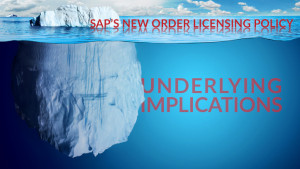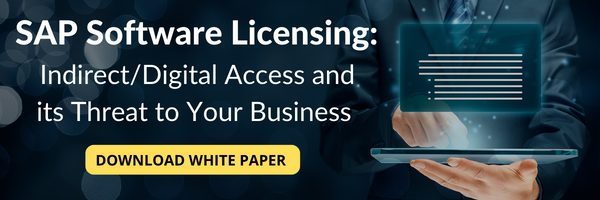- UpperEdge
- Reading Time: 3 minutes

Earlier this year, SAP’s announcement that external Procure-to-Pay (P2P) and Order-to-Cash (O2C) Indirect Use scenarios will be addressed via order licensing metrics was generally well received by the market. While many saw SAP’s clarification as a welcome first step towards a more transparent Indirect Use licensing methodology, UpperEdge cautioned against accepting the change as an act of empathy for SAP customers.
The announcement was likely a means to alleviate widespread concerns with SAP’s unpredictable approach to its licensing implications and non-compliance claims. However, validating the true value of the new order-based licensing methodology is dependent on fully understanding its underlying engines and pricing.
UpperEdge’s recent Indirect Access and traditional negotiation engagements reveal substantial changes to SAP’s order licensing methodology and unsurprisingly, companies continue to seek clarification beyond the high-level licensing guidelines SAP described. UpperEdge identified three aspects of the new policy that SAP customers should be aware of moving forward.
SAP Has “Re-Branded” its Engines
Historically, SAP offered only two order-based engine options (Sales & Service Order Processing or Purchase Execution). Their new order licensing policy introduces more options with far more specific naming conventions (e.g., Sales & Service Order Execution for B2B and B2C for S/4HANA) that depend on the type of engines you are using.
Given SAP’s history, this is a tactical name change and the true implications of it have not been clearly addressed in the company’s communications. These new, more precise naming conventions will likely affect your license grants and use rights. To avoid increased Indirect Access risk exposure or paying more for less service than was previously provided, customers should ensure they fully understand how the new license grants / use rights compare to their existing license grants / use rights for currently contracted engine(s).
SAP Has Increased Its List Pricing
SAP is substantially increasing the list pricing associated with its order-based engines. This should not come as a surprise as traditional order pricing does not sufficiently recoup the loss associated with the shift from user-based to order-based licensing as it relates to scenarios previously based upon user licensing (e.g., B2B scenarios).
It will be critical for customers to turn the validity of SAP’s order list pricing into a negotiation point, especially relative to customers who already own traditional SAP engines as part of their existing agreement.
Indirect Usage Remains Ambiguous
SAP’s July 2017 White Paper stated that external P2P and O2C Indirect Use scenarios relative to B2C, B2B and Devices would be addressed via order licensing. However, in practice, there still appears to be uncertainty with respect to the engine and pricing that would apply to each Indirect Use scenario.
We recommend obtaining SAP’s clarification on the applicable engine(s) and the associated list pricing relative to each scenario. In particular, existing SAP customers should push for SAP to honor any contracted engine(s) and pricing. It should be noted that SAP may push back in response by requesting more detailed discussions on specific usage areas (e.g. B2B, Devices).
Companies Should Still Prepare for Audits
Although SAP’s new Indirect Use policy brings a level of clarity on the licensing requirements for common external scenarios, the underlying pricing policy remains unclear. The level of financial risk continues to be difficult to assess for most organizations as licensing and pricing guidelines still lack clear definitions of both external and internal Indirect Use. Existing customers should obtain clarification as to the scope and breadth of the available order-based engines in any upcoming engagements with SAP.
Additionally, assessing your Indirect Access exposure can help your organization prepare for a potential audit and provide you with the knowledge necessary to develop a strong negotiation strategy and substantially mitigate your financial risk with SAP.
